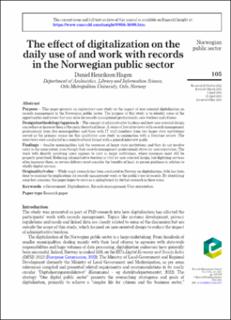The effect of digitalization on the daily use of and work with records in the Norwegian public sector
Peer reviewed, Journal article
Published version
Permanent lenke
https://hdl.handle.net/11250/3110477Utgivelsesdato
2023Metadata
Vis full innførselSamlinger
Sammendrag
Purpose
This paper presents an exploratory case study on the impact of user-oriented digitalization on records management in the Norwegian public sector. The purpose of this study is to identify some of the opportunities and issues that may arise for records management professionals, case workers and citizens.
Design/methodology/approach
The concept of administrative burdens and how user-oriented design can reduce or increase them is the main theoretical focus. A series of five interviews with records management professionals from five municipalities and three with IT staff members from two larger state institutions served as the primary source for this qualitative case study in conjunction with a literature review. The interviews were conducted in a semistructured format with a general interview guide.
Findings
Smaller municipalities lack the resources of larger state institutions, and they do not involve users in the same extent, even though their records management professionals strive for user-orientation. The work with directly involving users appears to vary in larger institutions, where resources must still be properly prioritized. Reducing administrative burdens is vital for user-oriented design, but digitizing services often increases them, so service delivery must consider the benefits of local, in-person guidance in relation to wholly digital services.
Originality/value
While much research has been conducted in Norway on digitalization, little has been done to examine the implications for records management work or the public’s use of records. By identifying some key concerns, this paper hopes to serve as a springboard for further research in these areas.

